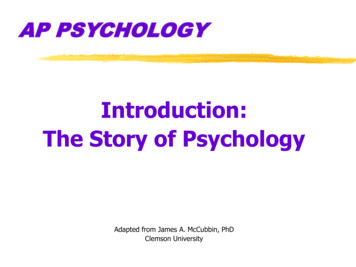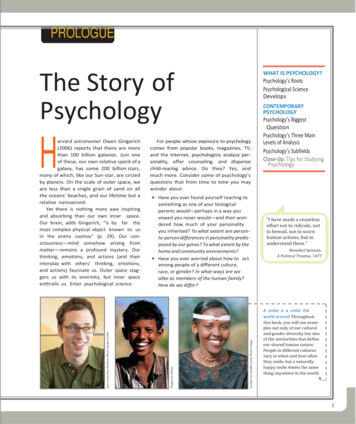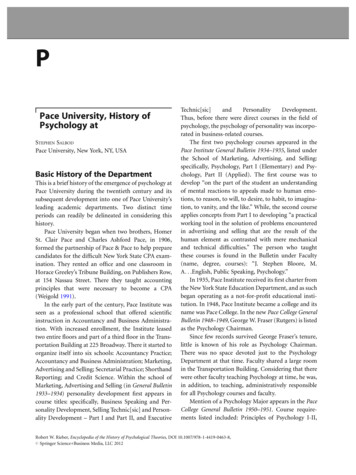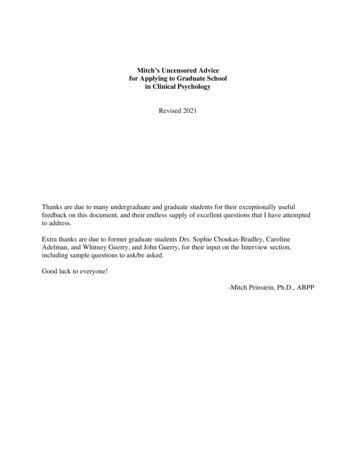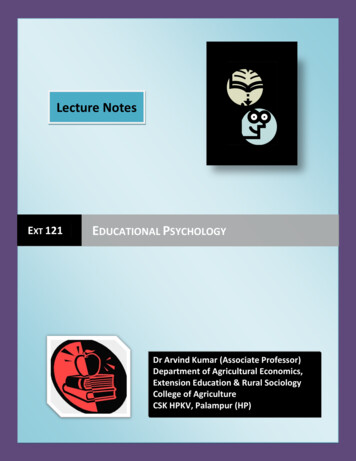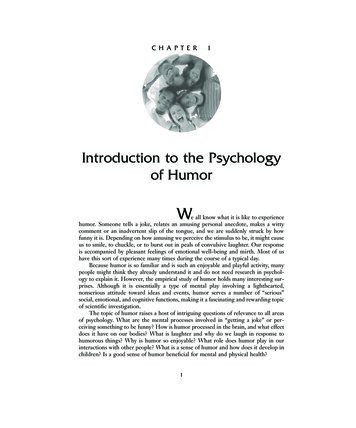
Transcription
ch001-P372564.qxd 15/8/06 9:56 AM Page 1C H A P T E R1Introduction to the Psychologyof HumorWe all know what it is like to experiencehumor. Someone tells a joke, relates an amusing personal anecdote, makes a wittycomment or an inadvertent slip of the tongue, and we are suddenly struck by howfunny it is. Depending on how amusing we perceive the stimulus to be, it might causeus to smile, to chuckle, or to burst out in peals of convulsive laughter. Our responseis accompanied by pleasant feelings of emotional well-being and mirth. Most of ushave this sort of experience many times during the course of a typical day.Because humor is so familiar and is such an enjoyable and playful activity, manypeople might think they already understand it and do not need research in psychology to explain it. However, the empirical study of humor holds many interesting surprises. Although it is essentially a type of mental play involving a lighthearted,nonserious attitude toward ideas and events, humor serves a number of “serious”social, emotional, and cognitive functions, making it a fascinating and rewarding topicof scientific investigation.The topic of humor raises a host of intriguing questions of relevance to all areasof psychology. What are the mental processes involved in “getting a joke” or perceiving something to be funny? How is humor processed in the brain, and what effectdoes it have on our bodies? What is laughter and why do we laugh in response tohumorous things? Why is humor so enjoyable? What role does humor play in ourinteractions with other people? What is a sense of humor and how does it develop inchildren? Is a good sense of humor beneficial for mental and physical health?1
ch001-P372564.qxd 15/8/06 9:56 AM Page 221 INTRODUCTION TO THE PSYCHOLOGY OF HUMORAs is evident from these and other related questions, humor touches on allbranches of academic psychology (R. A. Martin, 2000). Researchers in the area ofcognitive psychology may be interested in the mental processes involved in the perception, comprehension, appreciation, and creation of humor. The interpersonalfunctions of humor in dyadic interactions and group dynamics are of relevance tosocial psychology. Developmental psychologists may focus on the way humor andlaughter develop from infancy into childhood and throughout the lifespan. Personality researchers might examine individual differences in sense of humor and their relation to other traits and behaviors. Biological psychology can shed light on thephysiological bases of laughter and the brain regions underlying the comprehensionand appreciation of humor. The role of humor in mental and physical health, as wellas its potential applications in psychotherapy, education, and the workplace, are ofinterest to applied branches of psychology such as clinical, health, educational, andindustrial-organizational psychology. Thus, researchers from every branch of the discipline have potentially interesting contributions to make to the study of humor.Indeed, a complete understanding of the psychology of humor requires an integration of findings from all these areas.Despite the obvious importance of humor in many different areas of human experience and its relevance to all branches of psychology, mainstream psychology has paidsurprisingly little attention to this subject up to now. Humor research typicallyreceives scant mention, if any at all, in undergraduate psychology texts or scholarlybooks. Nonetheless, there has been a steady accumulation of research on the topicover the years, producing a sizable body of knowledge. The overall aim of thisbook is therefore to introduce students and academics in psychology, as well asscholars and professional practitioners from other fields, to the existing research literature, and to point out interesting avenues for further study in this fascinating topicarea.In this chapter, I will begin by summarizing evidence of the universality and evolutionary origins of humor and laughter in humans. I will then explore the questionof what humor is, discussing four essential elements of the humor process and the relevance of each to an integrative psychology of humor. This will be followed by asurvey of the many different forms of humor that we encounter during our daily lives,and an examination of the psychological functions of humor and laughter. Next, I willsummarize the history of the concept of humor, examining the way popular conceptions and assumptions about humor and laughter have changed dramatically over thecenturies. Finally, I will discuss the psychological approach to humor and then presentan overview of the rest of this book.THE UNIVERSALITY OF HUMOR AND LAUGHTERHumor and laughter are a universal aspect of human experience, occurring in allcultures and virtually all individuals throughout the world (Apte, 1985; Lefcourt,2001). Laughter is a distinctive, stereotyped pattern of vocalization that is easily rec-
ch001-P372564.qxd 15/8/06 9:56 AM Page 3THE UNIVERSALITY OF HUMOR AND LAUGHTERognized and quite unmistakable (Provine and Yong, 1991). Although different cultures have their own norms concerning the suitable subject matter of humor and thetypes of situations in which laughter is considered appropriate, the sounds of laughter are indistinguishable from one culture to another. Developmentally, laughter isone of the first social vocalizations (after crying) emitted by human infants (McGhee,1979). Infants begin to laugh in response to the actions of other people at about fourmonths of age, and cases of gelastic (i.e., laughter-producing) epilepsy in newbornsindicate that the brain mechanisms for laughter are already present at birth (Sher andBrown, 1976). The innateness of laughter is further demonstrated by the fact thateven children born deaf and blind have been reported to laugh appropriately withoutever having perceived the laughter of others (Provine, 2000). Indeed, there is evidenceof specialized brain circuits for humor and laughter in humans, which researchers arebeginning to identify by means of neural imaging studies. Thus, being able to enjoyhumor and express it through laughter seems to be an essential part of what it meansto be human.Interestingly, though, humans are not the only animal that laughs. Primatologistshave studied in some detail a form of laughter emitted by young chimpanzees, whichwas first described by Charles Darwin (1872). Similar types of laughter have also beenobserved in other apes, including bonobos, orangutans, and gorillas (Preuschoft andvan Hooff, 1997; van Hooff and Preuschoft, 2003). Ape laughter is described as a staccato, throaty, panting vocalization that accompanies the relaxed open-mouth or “playface,” and is emitted during playful rough-and-tumble social activities such aswrestling, tickling, and chasing games (see Figure 1). Although it sounds somewhatdifferent from human laughter, it is quite recognizable as such, occurring in similarsocial contexts as laughter in human infants and young children. Indeed, there is goodreason to believe that human and chimpanzee laughter have the same evolutionaryorigins and many of the same functions.In addition to laughter, there is evidence that apes may even have the capacity fora rudimentary sense of humor. Chimpanzees and gorillas that have been taught tocommunicate by means of sign language have been observed to use language in playfulways that are very reminiscent of humor, such as punning, humorous insults, andincongruous word use (Gamble, 2001). Interestingly, these humorous uses of linguistic signs are sometimes also accompanied by laughter and the play face, indicating aclose link between humor, play, and laughter even in apes.All of these lines of evidence suggest that humor and laughter in humans are aproduct of natural selection (Gervais and Wilson, 2005). Laughter appears to haveoriginated in social play and to be derived from primate play signals. It is viewed byevolutionary researchers as part of the nonverbal “gesture-call” system, which has along evolutionary history, predating the development of language (Burling, 1993).With the evolution of greater intellectual and linguistic abilities, humans have adaptedthe laughter-generating play activities of their primate ancestors to the mental playwith words and ideas that we now call humor (Caron, 2002). Thus, although theyusually do not chase and tickle one another in rough-and-tumble play, human adults,by means of humor, continue to engage in frequent social play. These evolutionary3
ch001-P372564.qxd 15/8/06 9:56 AM Page 441 INTRODUCTION TO THE PSYCHOLOGY OF HUMORF I G U R E 1 The chimpanzee play face. The characteristic “play face” (open mouth, upperteeth covered, lower teeth exposed) accompanies panting laughter. Getty Images/PhotoDiscorigins of humor and laughter suggest that they likely have important socialemotional functions that have contributed to our survival as a species.Although humor has a biological basis rooted in our genes, it is also evident thatcultural norms and learning play an important role in determining how it is used insocial interactions, and what topics are considered appropriate for it. In addition,although all forms of humor seem to originate in a basic play structure, the complexityof human language and imagination enables us to create humor in a seemingly endlessvariety of forms. As human language, culture, and technology have evolved, we havedeveloped new methods and styles of communicating it, from spontaneous interpersonal joking and banter to oral storytelling traditions, comedic drama and humorousliterature, comedy films, radio and television shows, and jokes and cartoons disseminated over the Internet.Besides being a form of playful fun and entertainment, humor has taken on a widerange of social functions over the course of human biological and cultural evolution.Many of these interpersonal functions are contradictory and paradoxical. Humor can
ch001-P372564.qxd 15/8/06 9:56 AM Page 5WHAT IS HUMOR?be a method of enhancing social cohesion within an in-group, but it can also be a wayof excluding individuals from an out-group. It can be a means of reducing but alsoreinforcing status differences among people, expressing agreement and sociability butalso disagreement and aggression, facilitating cooperation as well as resistance, andstrengthening solidarity and connectedness or undermining power and status. Thus,while originating in social play, humor has evolved in humans as a universal mode ofcommunication and social influence with a variety of functions.WHAT IS HUMOR?The Oxford English Dictionary defines humor as “that quality of action, speech, orwriting which excites amusement; oddity, jocularity, facetiousness, comicality, fun.” Itgoes on to say that humor is also “the faculty of perceiving what is ludicrous oramusing, or of expressing it in speech, writing, or other composition; jocose imagination or treatment of a subject” (Simpson and Weiner, 1989, p. 486). It is evidentfrom these definitions that humor is a broad term that refers to anything that peoplesay or do that is perceived as funny and tends to make others laugh, as well as themental processes that go into both creating and perceiving such an amusing stimulus, and also the affective response involved in the enjoyment of it.From a psychological perspective, the humor process can be divided into fouressential components: (1) a social context, (2) a cognitive-perceptual process, (3) anemotional response, and (4) the vocal-behavioral expression of laughter.The Social Context of HumorHumor is fundamentally a social phenomenon. We laugh and joke much morefrequently when we are with other people than when we are by ourselves (R. A. Martinand Kuiper, 1999; Provine and Fischer, 1989). People do occasionally laugh when theyare alone, such as while watching a comedy show on television, reading a humorousbook, or remembering a funny personal experience. However, these instances oflaughter can usually be seen as “pseudo-social” in nature, because one is still responding to the characters in the television program or the author of the book, or relivingin memory an event that involved other people.Humor can (and frequently does) occur in virtually any social situation. It canoccur between spouses who have lived together for fifty years or between strangerswaiting at a bus stop. It can take place in the conversation of a group of close friendscasually sitting around a table in a coffee shop, or in the interactions of a group ofbusiness people participating in formal negotiations. It can be used by public speakers, such as politicians or religious leaders, addressing large audiences either in personor via the media.The social context of humor is one of play. Indeed, humor is essentially a way forpeople to interact in a playful manner. As I have already noted, research on laughterin chimpanzees and other apes indicates that laughter originates in social play (van5
ch001-P372564.qxd 15/8/06 9:56 AM Page 661 INTRODUCTION TO THE PSYCHOLOGY OF HUMORHooff and Preuschoft, 2003). In humans, our ability to create humor to amuse oneanother and evoke laughter appears to have evolved as a means of providing us withextended opportunities for play. Play seems to serve important social, emotional, andcognitive functions (Bateson, 2005). Indeed, all mammals engage in play as juveniles,but, unlike most other animals, humans continue to play throughout their lives, mostnotably through humor.When they engage in play, people take a nonserious attitude toward the thingsthey are saying or doing, and they carry out these activities for their own sake—for the fun of it—rather than having a more important goal in mind. PsychologistMichael Apter (1991) has referred to the playful state of mind associated with humoras the paratelic mode, which he distinguishes from the more serious, goal-directed telicmode (from Greek telos goal). According to Apter, we switch back and forth betweenthese serious and playful states of mind many times during the course of a typical day.The humorous, playful mode of functioning can occur for brief moments or forextended periods of time. In a business meeting, for example, someone may make ahumorous quip that causes the group to laugh and enter the playful paratelic frameof mind for a brief moment, before resuming their more serious telic mode of discourse. In more casual settings, when people are feeling relaxed and uninhibited, theymay engage in playful and humorous storytelling and joke swapping for several hoursat a time.Cognitive-Perceptual Processes in HumorBesides occurring in a social context, humor is characterized by particular sortsof cognitions. To produce humor, an individual needs to mentally process information coming from the environment or from memory, playing with ideas, words, oractions in a creative way, and thereby generating a witty verbal utterance or a comicalnonverbal action that is perceived by others to be funny. In the reception of humor,we take in information (something someone says or does, or something we read)through our eyes and ears, process the meaning of this information, and appraise itas nonserious, playful, and humorous.What are the characteristics of a stimulus that cause us to perceive it to be funny?As we will see in the next two chapters, this question has been a topic of much scholarly debate and research for centuries (see also Roeckelein, 2002). Most investigatorswould agree, however, that humor involves an idea, image, text, or event that is insome sense incongruous, odd, unusual, unexpected, surprising, or out of the ordinary.In addition, there needs to be some aspect that causes us to appraise the stimulus asnonserious or unimportant, putting us into a playful frame of mind at least momentarily. Thus, the essence of humor seems to be incongruity, unexpectedness, and playfulness, which evolutionary theorists Matthew Gervais and David Wilson (2005)referred to as “nonserious social incongruity.” This constellation of cognitive elementsappears to characterize all forms of humor, including jokes, teasing, and witty banter,unintentional types of humor such as amusing slips of the tongue or the proverbialperson slipping on the banana peel, the laughter-eliciting peek-a-boo games and
ch001-P372564.qxd 15/8/06 9:56 AM Page 7WHAT IS HUMOR?rough-and-tumble play of children, and even the humor of chimpanzees and gorillas(Wyer and Collins, 1992).Arthur Koestler (1964) coined the term bisociation to refer to the mental processinvolved in perceiving humorous incongruity. According to Koestler, bisociationoccurs when a situation, event, or idea is simultaneously perceived from the perspective of two self-consistent but normally unrelated and even incompatible frames ofreference. Thus, a single event “is made to vibrate simultaneously on two differentwavelengths, as it were” (p. 35). A simple example is a pun, in which two differentmeanings of a word or phrase are brought together simultaneously (e.g., Two cannibals are eating a clown. One says to the other, “Does this taste funny to you?”).According to Koestler, this same process underlies all types of humor.Michael Apter (1982) used the concept of synergy to describe this cognitiveprocess, in which two contradictory images or conceptions of the same object are heldin one’s mind at the same time. In the playful paratelic state, according to Apter, synergies are enjoyable and emotionally arousing, producing the pleasurable sensation ofhaving one’s thoughts oscillate back and forth between two incompatible interpretations of a concept. Thus, in humor, we playfully manipulate ideas and activities sothat they are simultaneously perceived in opposite ways, such as real and not real,important and trivial, threatening and safe. As we will see in later chapters, a greatdeal of theoretical discussion and research in the psychology of humor has focusedon exploring in greater detail the cognitive processes underlying the perception andappreciation of humor.Emotional Aspects of HumorOur response to humor is not just an intellectual one. The perception of humorinvariably also evokes a pleasant emotional response, at least to some degree. Psychological studies have shown that exposure to humorous stimuli produces an increasein positive affect and mood (Szabo, 2003). The emotional nature of humor is alsoclearly demonstrated by recent brain imaging research showing that exposure tohumorous cartoons activates the well-known reward network in the limbic system ofthe brain (Mobbs et al., 2003). The funnier a particular cartoon is rated by a participant, the more strongly these parts of the brain are activated. From other research,we know that these same brain circuits underlie pleasurable emotional states associated with a variety of enjoyable activities including eating, listening to enjoyablemusic, sexual activity, and even ingestion of mood-altering drugs. This explains whyhumor is so enjoyable and why people go to such lengths to experience it as often asthey can: whenever we laugh at something funny, we are experiencing an emotionalhigh that is rooted in the biochemistry of our brains.It can therefore be argued that humor is essentially an emotion that is elicited bythe particular types of cognitive processes discussed in the previous section. Just asother emotions like joy, jealousy, or fear occur in response to specific types ofappraisals of the social and physical environment (Lazarus, 1991), so humor comprisesan emotional response that is elicited by a particular set of appraisals, namely the7
ch001-P372564.qxd 15/8/06 9:56 AM Page 881 INTRODUCTION TO THE PSYCHOLOGY OF HUMORperception that an event or situation is incongruously funny or amusing. The pleasant emotion associated with humor, which is familiar to all of us, is a unique feelingof well-being that is described by such terms as amusement, mirth, hilarity, cheerfulness,and merriment. It is closely related to joy, and contains an element of exultation anda feeling of invincibility, a sense of expansion of the self that the seventeenth-centuryEnglish philosopher Thomas Hobbes referred to as “sudden glory.”Surprisingly, although it is a feeling that is familiar to everyone, scholars have notyet settled on an agreed-upon technical term to denote this particular emotion.Researchers have specific terms to denote emotions like joy, love, fear, anxiety, depression, and so forth, but there is no common name for the emotion elicited by humor.This is because it is so closely aligned with laughter that, until recently, theorists andresearchers have tended to focus on the more obvious behavior of laughter instead ofthe emotion that underlies it. Some researchers have used the expressions “humorappreciation” (e.g., Weisfeld, 1993) or “amusement” (e.g., Shiota et al., 2004) todenote this emotion, but these terms seem to be too cognitive and do not fully captureits emotional nature. Psychologist Willibald Ruch (1993) has proposed the word exhilaration (related to hilarity, from Latin hilaris cheerful) as a technical term for thisemotion. While exhilaration, in its common English meaning, contains a sense ofexcitement in addition to cheerfulness, Ruch suggested that this use of the term wouldde-emphasize the excitement component, underscoring instead the emotional qualityof cheerfulness, amusement, and funniness. However, this term does not seem to havecaught on with researchers, who likely have difficulty shedding the connotation ofexcitement.To denote this emotion, we need a term that is clearly emotion-related and isassociated with humor and laughter but without being synonymous with either one,and which can have a range of intensities. In my view, the word mirth works very wellfor this purpose. The Oxford English Dictionary defines mirth as “pleasurable feeling,. . . joy, happiness; gaiety of mind, as manifested in jest and laughter; merriment, hilarity” (Simpson and Weiner, 1989, p. 841). This seems to be exactly the requiredmeaning. Some researchers have used the word mirth to refer to smiling and laughter, which are facial and vocal expressions of the emotion rather than the emotionitself, and therefore should be kept distinct. In this book, then, I will refer to thisemotion as mirth.Mirth, then, is the distinctive emotion that is elicited by the perception of humor.Like other emotions (e.g., joy, love, sadness, fear), mirth can occur with varyingdegrees of intensity, ranging from mild feelings of amusement to very high levels ofhilarity (Ruch, 1993). Also like other emotions, mirth has physiological as well as experiential components. Along with the distinctive subjective feelings of pleasure, amusement, and cheerfulness, this emotion is accompanied by a range of biochemicalchanges in the brain, autonomic nervous system, and endocrine system, involving avariety of molecules, including neurotransmitters, hormones, opioids, and neuropeptides (Panksepp, 1993). This neurochemical cocktail has further effects on many partsof the body, including the cardiovascular, muskuloskeletal, digestive, and immunesystems (W. F. Fry, 1994). The biological concomitants of the emotion of mirth form
ch001-P372564.qxd 15/8/06 9:56 AM Page 9WHAT IS HUMOR?the basis of claims that have been made in recent years about potential health benefits of humor and laughter. However, the exact nature of the physiological changesaccompanying mirth is not yet well understood, and further research is needed beforewe can say with confidence whether these effects have significant health benefits(R. A. Martin, 2001, 2002).The essentially emotional nature of humor is something that many scholars havefailed to recognize until quite recently. In the past, most theorists and researchers haveviewed it as primarily a cognitive process rather than an emotional one. A great dealof philosophical debate and research effort has been expended on attempts to identify the precise cognitive-perceptual elements that are necessary and sufficient forhumor to occur, with little recognition of the fact that what these cognitive appraisalselicit is an emotion. This would be like researchers who study depression or anxietyspending all their time debating about the specific types of events and cognitiveappraisals that elicit these mood states without ever noticing their emotional nature.Although much has been learned about the cognitive aspects of humor (and there isstill more work to do in this area), theory and research directed at the emotional component of humor has only recently begun. Recent research efforts bridging social andbiological psychology hold particular promise for further exciting breakthroughs inthis area.Laughter as an Expression of the Emotion of MirthLike other emotions, the mirthful pleasure accompanying humor also has anexpressive component, namely laughter and smiling. At low levels of intensity, thisemotion is expressed by a faint smile, which turns into a broader grin and then audiblechuckling and laughter as the emotional intensity increases. At very high intensities,it is expressed by loud guffaws, often accompanied by a reddening of the face as wellas bodily movements such as throwing back the head, rocking the body, slapping one’sthighs, and so on. Thus, laughter is essentially a way of expressing or communicating to others the fact that one is experiencing the emotion of mirth, just as frowning,scowling, yelling, and clenching one’s fists communicate the emotion of anger. Laughter is therefore fundamentally a social behavior: if there were no other people to communicate to, we would not need laughter. This is no doubt why it is so loud, why itcomprises such a distinctive and easily recognized set of sounds, and why it rarelyoccurs in social isolation.As we have already seen, the laughter of chimpanzees and other apes is typicallyaccompanied by a characteristic facial expression called the relaxed open-mouthdisplay, or play face, which is also seen in other primates and is shown during play.Many theorists have suggested that the main function of laughter, in humans as wellas apes, is to signal to others that one is engaging in play, rather than being serious(e.g., van Hooff, 1972). When chimpanzees are playfully fighting and chasing eachother, it is important for them to be able to let each other know that they are justhaving fun and not seriously intending to harm one another. In humans also, laughter can be a signal of friendliness and playful intentions, indicating that one is in a9
ch001-P372564.qxd 15/8/06 9:56 AM Page 10101 INTRODUCTION TO THE PSYCHOLOGY OF HUMORnonserious frame of mind. The laughter accompanying friendly teasing, for example,signals that a seemingly insulting message is not to be taken seriously.More recently, researchers have suggested that the purpose of laughter is not justto communicate that one is in a playful state, but to actually induce this state in othersas well (Owren and Bachorowski, 2003; Russell, Bachorowski, and Fernandez-Dols,2003). According to this view, the peculiar sounds of laughter have a direct effect onthe listener, inducing positive emotional arousal that mirrors the emotional state ofthe laugher, perhaps by activating certain specialized brain circuits (Gervais andWilson, 2005; Provine, 2000). In this way, laughter may serve an important biosocialfunction of coupling together the positive emotions of members of a group andthereby coordinating their activities. This would explain why laughter is so contagious; when we hear someone laughing, it is almost impossible not to feel mirthfuland begin laughing too. Yet another potential social function of laughter is to motivate others to behave in particular ways (Shiota et al., 2004). For example, laughtercan be a method of positively reinforcing others for desirable behavior (“laughingwith”), as well as a potent form of punishment directed at undesirable behaviors(“laughing at”).In summary, the psychological process of humor involves a social context, acognitive appraisal process comprising the perception of playful incongruity, the emotional response of mirth, and the vocal-behavioral expression of laughter. Neurological studies indicate that these different components of the humor process involvedifferent but interconnected regions of the brain (Wild et al., 2003). The word humoris often used in a narrow sense to refer specifically to the cognitive-perceptual component, the mental processes that go into creating or perceiving something funny oramusing. I will also occasionally use it in this narrow sense, since there does not seemto be another word to denote this cognitive process. It is important to bear in mind,though, that in a broader sense, humor refers to all four components, and all of themneed to be addressed in an integrative psychology of humor.THE MANY FORMS OF HUMORWe have seen that humor is essentially an emotional response of mirth in a socialcontext that is elicited by a perception of playful incongruity and is expressed throughsmiling and laughter. Although these basic elements are common to all instances ofhumor, the range of social situations and events that can elicit the humor response isremarkably diverse. During the course of a typical day, we encounter many differentforms of humor communicated by different means and for different purposes. Someof this humor comes to us via the mass media. Radio hosts frequently crack jokes andmake witty comments; television provides us with a constant diet of humor in theform of sitcoms, blooper shows, stand-up comedy, political satire, and humorousadvertisements; and we encounter it also in newspaper comic strips and cartoons,comedy movies, and humorous books. Humor is also often used in speeches, sermons,and lectures by politicians, religious leaders, motivational speakers, and teachers.
ch001-P372564.qxd 15/8/06 9:56 AM Page 11THE MANY FORMS OF HUMORHowever, most of the humor and
rience and its relevance to all branches of psychology, mainstream psychology has paid surprisingly little attention to this subject up to now. Humor research typically receives scant mention, if any at all, in undergraduate psychology texts or scholarly books. Nonetheless, ther





